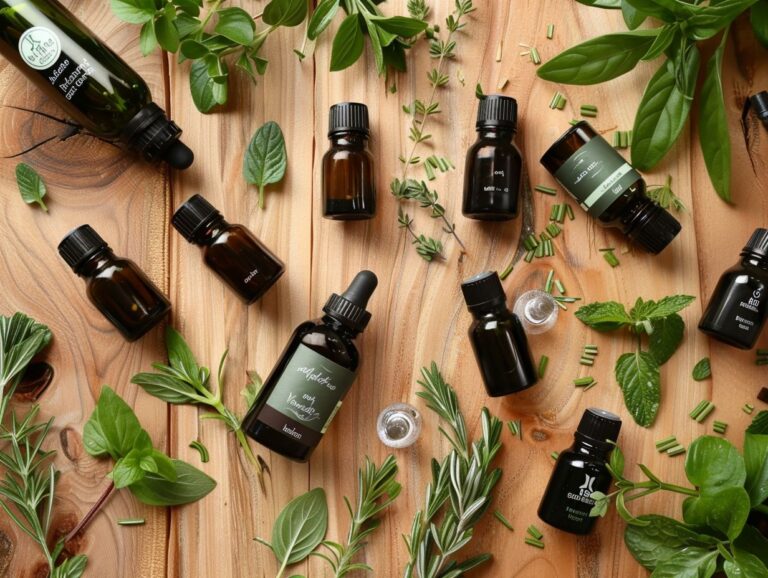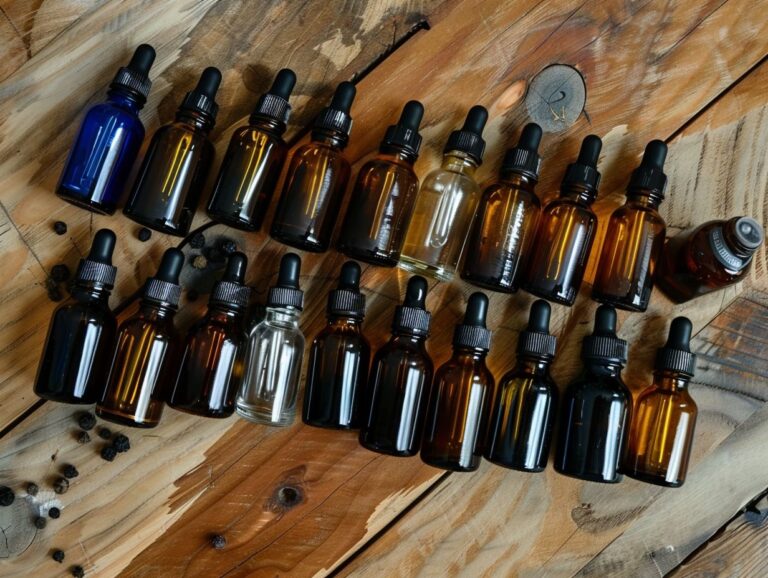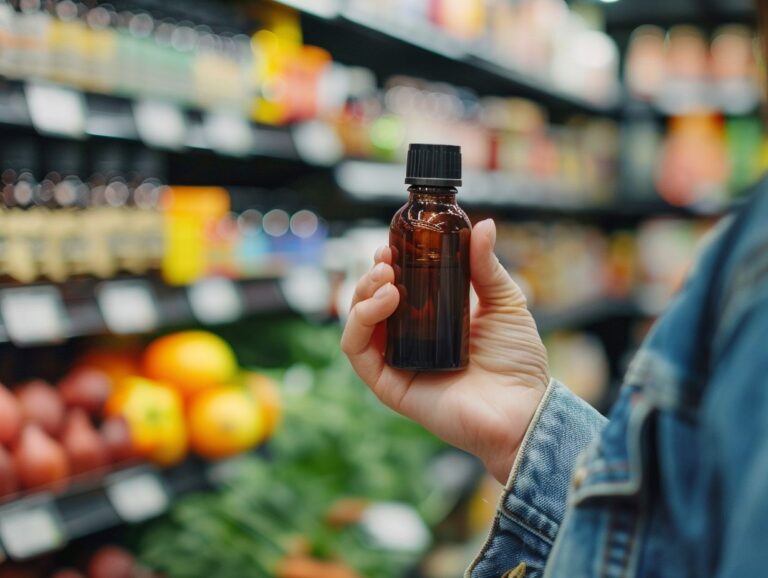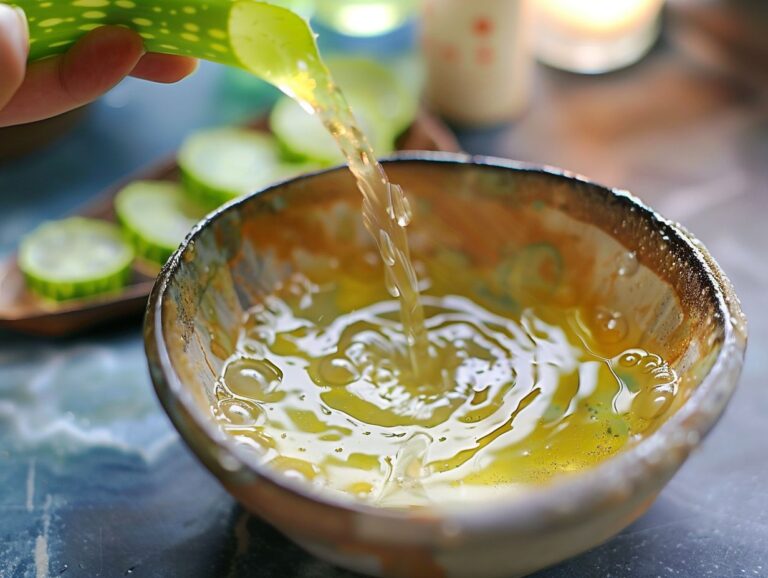Are Essential Oils Notes
Essential oils have become increasingly popular in recent years for their various health and wellness benefits.
In this comprehensive guide, explore what essential oils are, the different types available, and how they are made through processes like distillation and expression.
We will also discuss the wide range of uses for essential oils, including in aromatherapy and skincare.
Find important safety precautions to consider when using essential oils and tips for choosing and storing them effectively.
Whether you are new to essential oils or a seasoned user, gain valuable insights to enhance your essential oil experience.
Key Takeaways:
What are Essential Oils?
Essential oils are highly concentrated plant extracts that capture the natural scent or essence of the plant. These oils are commonly used in perfumes, aromatherapy, and other applications for their fragrance and therapeutic properties.
Extraction of essential oils is a meticulous process that involves methods like steam distillation or cold pressing to ensure that the purest form of the oil is obtained. Once extracted, these oils offer a range of benefits, including stress relief, mood enhancement, and even potential health benefits.
Aromatherapy is a popular practice that utilizes essential oils to promote relaxation and overall well-being. Many enthusiasts also enjoy blending different oils to create unique scents that suit their preferences, making these oils an essential ingredient in the art of creating personalized perfumes.”
What are the Different Types of Essential Oils?
Essential oils are classified into three main categories: top notes, middle notes, and base notes, based on their evaporation rates. Top notes are the most volatile and evaporate quickly, while base notes evaporate slowly.
Top notes, also known as ‘head’ notes, provide the initial impression of a blend with their fresh, light, and uplifting aromas. They consist of oils like citrus, peppermint, and eucalyptus, adding brightness and excitement to a fragrance.
Middle notes, or ‘heart’ notes, form the core of a blend, balancing the top and base notes. These oils, such as lavender, chamomile, and rosemary, offer a harmonious transition and floral aroma.
Base notes, often referred to as ‘fixatives,’ are deep, rich scents like sandalwood, cedarwood, and vanilla, providing stability and depth to the overall blend.
How are Essential Oils Made?
Essential oils are primarily extracted through two main methods: distillation and expression. Distillation involves the use of steam to extract the oils, while expression is a mechanical method of pressing the oils from the plant material.
During distillation, the plant material is placed in a distillation apparatus where steam is passed through it. The steam helps to break down the plant cells and release the essential oils. The steam and oil mixture is then cooled, leading to the separation of the essential oil from the water. On the other hand, expression is commonly used for citrus fruits where the rinds are pressed to extract the oils.
What is the Process of Distillation?
Distillation is a common method used to extract essential oils from plant material. It involves heating the plant material to release the aromatic compounds, which are then captured and condensed into a liquid form.
There are different types of distillation methods used in this process, each with its own unique approach. Steam distillation, for example, is a widely employed technique where steam is passed through the plant material, carrying the essential oils with it. On the other hand, water distillation involves directly boiling the plant material in water.
- The role of temperature and pressure in distillation is crucial, as they influence the efficiency of the extraction process. By controlling these variables, distillers can optimize the yield and quality of the essential oils.
Proper distillation techniques are essential to ensure the purity and potency of the final product. Implementing correct procedures, such as using a fixative to enhance scent longevity or selecting the right perfumery notes, plays a significant role in producing high-quality essential oils.
What is the Process of Expression?
Expression, also known as cold pressing, is a method used to extract essential oils from the rind of citrus fruits. It involves mechanically pressing the fruit to release the oils, which are then separated from the juice and other components.
Compared to distillation, expression is a simpler and quicker method that is particularly suitable for citrus fruits due to their high oil content in the rind. The process retains the fresh, vibrant aroma of the citrus oils, making them popular choices among herbalists and those who prefer to create their own essential oil blends. Specialized equipment such as manual or hydraulic presses are commonly used for this extraction method, ensuring that the oils remain pure and unaltered by heat or chemicals. The resulting oils are often of higher quality and are prized for their intense fragrance and therapeutic properties.
What are the Uses of Essential Oils?

When used in aromatherapy, essential oils like lavender and peppermint can help reduce stress, improve mood, and promote relaxation. In skincare products, oils such as tea tree oil and rosehip oil are popular for their anti-inflammatory and hydrating properties, benefiting the skin in numerous ways. Some essential oils have been found to aid in digestion, like ginger oil which can help soothe an upset stomach. Whether diffused in the air or applied topically, these remedies derived from nature continue to be utilized for their holistic healing benefits.
How are Essential Oils Used in Aromatherapy?
Aromatherapy utilizes essential oils to promote physical and psychological well-being. These oils can be inhaled, applied topically, or used in diffusers to create a therapeutic environment that enhances relaxation, energy, or focus.
Classification of essential oils is typically based on their therapeutic properties where they can be categorized into relaxing, energizing, or focusing oils.
Relaxing oils
- Lavender
- Chamomile
Relaxing oils such as lavender and chamomile are commonly used to induce a sense of calm and promote better sleep.
Energizing oils
- Peppermint
- Citrus oils
Energizing oils like peppermint and citrus oils can boost energy levels and improve mental alertness.
Focusing oils
- Rosemary
- Basil
On the other hand, focusing oils such as rosemary and basil are known for enhancing concentration and aiding cognitive function.
What are the Benefits of Using Essential Oils in Skincare?
Essential oils are popular in skincare products due to their natural properties that can benefit the skin. They can help with hydration, inflammation, and overall skin health when properly incorporated into cleansers, serums, and moisturizers.
One of the significant advantages of using essential oils in skincare is their ability to cater to various skin types. Whether you have dry, oily, combination, or sensitive skin, there is an essential oil that can address your specific needs. For instance, lavender oil is excellent for soothing sensitive skin, while tea tree oil is known for its antibacterial properties that help control oil production in acne-prone skin.
Can Essential Oils be Ingested?
While some essential oils can be ingested in small amounts for therapeutic purposes, it is crucial to exercise caution and consult with a qualified professional before internal use. Not all oils are safe for ingestion and may cause adverse effects if consumed incorrectly.
When considering ingesting essential oils, it is important to adhere to proper dosages recommended by experts to avoid toxicity and potential harm to the body. Suitable oils for ingestion often include those known for their gentle nature and digestive support properties, such as peppermint, lemon, or lavender. These oils are believed to work in synergy with the body when taken internally, promoting overall well-being. It is essential to be aware of the potential risks, such as irritation of the gastrointestinal tract or affecting the nervous system if not used appropriately.
What are the Safety Precautions for Using Essential Oils?
While essential oils offer numerous benefits, it is essential to follow safety precautions when using them. These precautions include understanding potential side effects, interactions with medications, and ensuring the safety of children and pets in the vicinity.
When working with essential oils, it’s crucial to be aware of the risk of allergic reactions and skin sensitivities. Always perform a patch test before applying directly to the skin.
Proper dilution is key to prevent skin irritation; remember that less is often more when it comes to essential oils. If you’re using essential oils as fixatives in blends, pay attention to maintaining the right balance to avoid overwhelming scents. Be mindful of using essential oils around individuals who are pregnant, elderly, or have underlying health conditions.
What are the Potential Side Effects of Essential Oils?
Although natural, essential oils can have side effects if used improperly. These side effects may include skin irritation, allergic reactions, respiratory issues, or headaches, especially in cases of sensitivity or incorrect application.
It’s crucial to be aware of these potential reactions to essential oils in order to use them safely and effectively. Skin irritation typically manifests as redness, itching, or a rash, indicating a need to dilute the oil or discontinue use.
Allergic reactions can present as hives, swelling, or difficulty breathing, and in severe cases, immediate medical attention is necessary.
Respiratory issues may occur due to inhaling concentrated oils, leading to coughing, shortness of breath, or chest tightness. In such instances, moving to a well-ventilated area is advised.
Headaches can also result from strong scents or overuse. To prevent this, notes dilution and moderation are key.
Can Essential Oils Interact with Medications?

Essential oils have the potential to interact with certain medications, either by enhancing or inhibiting their effects. It is crucial to consult with a healthcare professional before using essential oils alongside any prescribed medications to avoid unintended interactions.
When essential oils are applied on the skin or inhaled, they release volatile compounds that can interact with medications at a molecular level. These volatile compounds are known for their ability to evaporate quickly, potentially leading to changes in the way medications are metabolized by the body. For example, citrus oils like grapefruit can interfere with enzymes responsible for breaking down certain drugs, causing them to accumulate in the body to dangerous levels.
Are Essential Oils Safe for Children and Pets?
While essential oils can offer benefits to adults, special caution is needed when using them around children and pets. Some oils can be toxic to animals or cause adverse reactions in young children, so it’s essential to research pet-safe and child-safe oils.
When choosing oils to use around children and pets, opt for gentle and pet-friendly options. Lavender, chamomile, and ylang-ylang are generally considered safe for both kids and pets. Dilution is key when using essential oils – always blend them with a carrier oil such as coconut or almond oil before applying topically or diffusing. Be cautious of strong oils like eucalyptus or tea tree, as they may be too intense for children or animals. If diffusing oils, ensure that pets have the option to leave the room if they are bothered by the scent.
How to Choose and Store Essential Oils?
Selecting and storing essential oils correctly is crucial to preserve their quality and efficacy.
When looking for high-quality essential oils, it is imperative to pay attention to various crucial factors. The purity of the oil plays a vital role in determining its therapeutic benefits. Opt for oils that are sourced from reputable suppliers, ideally from plants grown in their natural habitat to ensure the integrity of the formula. Select oils that have undergone stringent testing procedures to guarantee their potency and authenticity.
What to Look for When Purchasing Essential Oils?
When purchasing essential oils, it is important to look for indicators of quality such as botanical names, purity percentage, extraction methods, and certifications from reputable organizations.
Authenticity is key when selecting essential oils. To ensure you are getting a high-quality product, check for botanical names that match the specific plant or source. Pay attention to the purity percentage, as genuine oils are often undiluted. Understanding extraction methods can also provide insight into the oil’s quality and effectiveness. Look for certifications from trusted organizations like the National Association for Holistic Aromatherapy (NAHA) or the Alliance of International Aromatherapists (AIA) to guarantee profound and therapeutic-grade oils. Consider reputable brands or suppliers that prioritize balance and transparency in their products.
How to Properly Store Essential Oils?
Proper storage is essential to maintain the potency and shelf life of essential oils. Oils should be kept in dark glass bottles away from sunlight, heat, and moisture to prevent oxidation and preserve their aromatic properties.
Storing essential oils in dark glass bottles helps shield them from light exposure, which can cause degradation. It is advisable to keep the bottles in a cool, dry place to prevent evaporation of the volatile compounds in the oils. Ensure that the lids of the containers are securely closed to avoid unnecessary air exposure. Factors such as fluctuating temperatures, direct sunlight, and air can accelerate the breakdown of the oils, affecting their blend and therapeutic properties over time.
Frequently Asked Questions
Are Essential Oils Notes?

No, essential oils are not notes in the traditional sense. Notes refer to the different components or scents in a fragrance, while essential oils are concentrated plant extracts used for their therapeutic properties.
Can I Use Essential Oils as Fragrance Notes in Perfumes?
Yes, you can use essential oils as fragrance notes in perfumes. However, keep in mind that essential oils have a strong and distinct scent, so it’s important to balance them properly with other fragrance notes.
Do Essential Oils Have Scent Profiles Similar to Perfume Notes?
Some essential oils may have scent profiles similar to traditional perfume notes, but not all of them. Essential oils are derived from plants, so their scents may vary depending on the type of plant and the extraction process.
Are Essential Oils Notes Safe to Use on the Skin?
It depends on the essential oil and its concentration. Some essential oils can be safely used on the skin, while others may cause irritation or allergic reactions. It’s important to properly dilute essential oils and do a patch test before applying them topically.
Are Essential Oils the Same as Synthetic Fragrance Notes?
No, essential oils and synthetic fragrance notes are not the same. While essential oils are derived from natural sources, synthetic fragrance notes are created in a lab using artificial ingredients. They may have a similar scent, but their properties and effects on the body may differ.
Can I Use Essential Oils Notes in Aromatherapy?
Yes, essential oils are commonly used in aromatherapy for their therapeutic benefits. However, it’s important to use them properly and consult with a certified aromatherapist for guidance on the right oils and their safe usage.








2 Comments